As someone who appreciates historical fashion, particularly the elegance of the Victorian era, I’ve often pondered the realities of clothing for women in different times and places. Being rooted in the Southwest and fascinated by pioneer history, I became curious about how fashion differed for women on the Western frontier compared to their counterparts in established Eastern cities during the 19th century. This exploration led me to uncover the practical yet stylish world of Pioneer Woman Attire.
Pioneer women faced unique challenges when it came to their wardrobes. Balancing practicality, social expectations, and personal style was key. This post delves into the essential elements of their clothing, setting the stage for a deeper look into specific aspects of frontier fashion in future articles. Join me as we uncover the basics of pioneer women’s wardrobes!
Defining the Frontier Context
For this discussion, “frontier” refers to the regions west of Missouri and Arkansas, roughly spanning the period from 1850 to 1890. The focus is on the clothing worn by women homesteaders and those living in settlement communities, primarily white settlers migrating westward from the East.
What’s particularly intriguing is that frontier clothing emphasized practicality and community spirit over social status and overt displays of wealth. It reflected the shared experience of families pursuing their dreams and exploring the vast, unknown West.
Essential Undergarments
Interestingly, the foundational undergarments worn by women on the frontier were quite similar to those in Eastern cities. The chemise, a light cotton slip, served as the primary underlayer, prioritized for hygiene and frequent washing. Pantalets, made of flannel or cotton, were worn next for modesty – acting as a precursor to modern underwear.
Contrary to some assumptions, corsets were a common garment among pioneer women. Many women journeying west were driven by aspirations for a better future for their families, whether for economic or religious reasons. They were “proper” and proud women who generally maintained the fashion norms of the time, including the corset, considered a fundamental part of respectable attire.
While corsets might be loosened or temporarily forgone during strenuous housework, most frontier women brought corsets with them and wore them whenever feasible.
Following the corset came petticoats, a layered skirt worn to give dresses their shape. Frontier women often owned multiple petticoats, choosing among them based on the formality of the occasion or the weather. Stockings were essential when leaving the house or receiving guests, typically held up by garters or tucked into pantalets – a detail that might seem rather uncomfortable to us today!
Fabrics of the Frontier
Calico emerged as the dominant fabric choice for pioneer clothing. Often visualized as quaint floral prints, calico is actually a type of plain-woven cotton fabric, slightly lighter than canvas. Its lightweight yet sturdy and easily washable nature made it ideal for the demands of outdoor life. While general stores offered some pre-dyed options, women frequently dyed calico themselves using commercially available dyes or natural dyes derived from local plants like leaves, bark, berries, and fruits.
Cotton and silk fabrics were still reserved for “Sunday best” outfits and more formal dresses, and many women brought such garments with them as they moved West.
By this era, fabrics were generally available at general stores, though accessibility varied greatly depending on location. In more remote areas, families often had to produce their own fabrics, a complex skill set worthy of its own dedicated discussion.
Everyday Pioneer Dresses
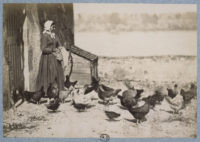
Regardless of their previous social standing in the East, women in frontier settlements were integral to establishing and maintaining homes and farms. Daily life involved cooking, cleaning, childcare, laundry, and often fieldwork. The success of family farms depended on everyone’s physical labor, with no room for outsourcing domestic tasks. Frontier women adapted quickly to a life filled with manual work.
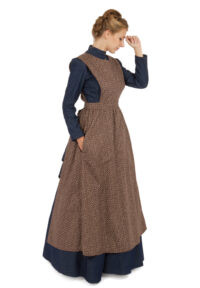
Pioneer Calico Apron
The prevailing dress styles of the time, featuring fitted bodices and full skirts, were adapted for pioneer living. Skirts for everyday wear were hemmed approximately three inches shorter to facilitate movement. Weights might also be sewn into the hems to prevent skirts from blowing up in windy conditions and ensuring modesty.
Bodices remained fitted, but sleeves were loosened and extended to the wrists, paired with high collars for sun protection.
Laundering pioneer clothing was a significant chore, one that women undertook regardless of prior experience. An interesting mention of “wash dresses” appears in Chris Enss’s book, How the West Was Worn. These “wash dresses,” popular by 1867, were two-piece white cotton dresses with printed backgrounds, valued for their easy care. Sold in stores and copied by seamstresses, they were worn across socioeconomic lines. While further research is needed on “wash dresses,” their emergence highlights fashion’s adaptability to the practical needs of frontier life.
Sunday Best on the Frontier

While some families lived in isolated locations, settlements with multiple families typically had churches, and church attendance was a strong community expectation. Although accounts exist of women in impoverished communities attending church barefoot, it was more common for women to have at least one or two dresses specifically for Sundays. However, historical records often focus on more privileged settlers, making it difficult to definitively know the most prevalent reality.
Frontier women’s “Sunday best” closely resembled fashionable city attire. Full skirts, worn over petticoats and corsets, were standard. Sleeve styles of the period, such as bell, leg-o-mutton, or pagoda sleeves, would have been incorporated. Staying current with skirt styles, whether crinoline, hoop, or bustle, was also a consideration for Sunday dresses, depending on the decade.
Color choices reflected age and marital status: younger and newly married women favored lighter colors, transitioning to darker shades within a few years. Sunday ensembles were completed with the most fashionable hats available, kid gloves, and low-heeled boots.
Social Occasions: Frontier Party Dresses
For women with the means, a separate dress was reserved for social gatherings, in addition to daily wear and Sunday attire. Dances, holiday celebrations, picnics, and other community events provided opportunities to socialize. Just as in Eastern cities, women dressed for these occasions.
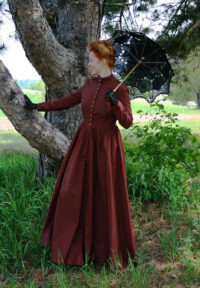
Mary Chestnut’s Americana Victorian Cotton Dress
These social dresses were highly valued. Women might order fabrics from general stores and eagerly await the chance to create the latest styles. Godey’s Ladies Book was a widely circulated magazine, with frontier women enthusiastically sharing copies to replicate dress patterns and styles featured within.
Fabric availability for new dresses depended heavily on the proximity to towns and general stores. In more remote areas, women might not have had the luxury of choosing outfits. In such cases, their finest dress served for special events, enhanced with embellishments like hand-crocheted collars and shawls, along with other accessories.
Frontier Accessories: The Finishing Touches
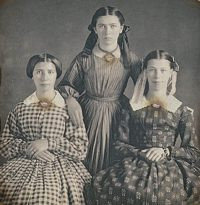
Researching pioneer woman attire revealed the significant role of accessories. Beyond hoop skirts and calico, accessories were essential for completing and personalizing an outfit. Their importance was consistently highlighted in historical accounts, prompting a plan to dedicate a future post to exploring frontier accessories in detail.
Accessories frequently used by women on the frontier included:
- Aprons
- Boots
- Brooches
- Lockets
- Earrings
- Precious stones and metals
- Hair adornments
- Hats
- Collars and cuffs
- Gloves
- Undersleeves
- Parasols
- Fans
- Handbags
- Shawls
Legacy of Pioneer Style
My growing interest in my own pioneer ancestry has deepened my appreciation for this historical period. While “prairie style,” “pioneer,” and “western wear” clothing are readily available today, understanding the historical context of how pioneer women navigated their desires for propriety, beauty, and fashion amidst the demands of frontier life is fascinating.
This topic warrants further exploration, and I invite you to look out for an upcoming post focusing on accessories in frontier fashion.
Embodying the Pioneer Look Today:
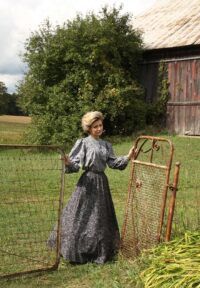 Woman in pioneer clothing standing in a field wearing a long-sleeved blue top and long blue skirt.
Woman in pioneer clothing standing in a field wearing a long-sleeved blue top and long blue skirt.
Pioneer Calico Blouse and Skirt
Browse our entire pioneer clothing collection
Pioneer Calico Blouse and Skirt
Harper Victorian Pioneer Dress
Pioneer Blouse, Apron and Skirt
